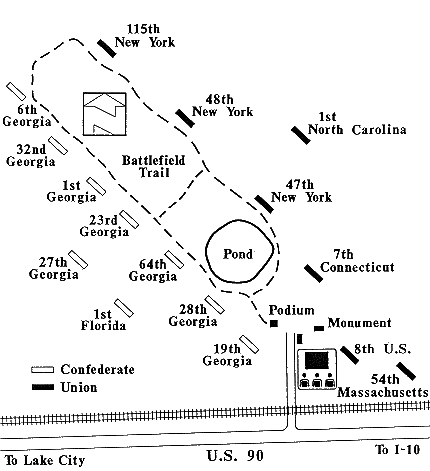

The Union campaign that climaxed in the Battle of Olustee (or Ocean Pond) began in February, 1864, when troops commanded by General Truman A. Seymour embarked at Hilton Head, S.C. Their immediate objective was a fourth occupation of Jacksonville. The force could then disrupt transportation links and deprive the Confederacy of food supplies from central Florida; capture cotton, turpentine and timber; gain black recruits for the Union army; and induce Unionists in east Florida to organize a loyal state government.
Seymour's expeditionary force landed at Jacksonville on February 7, 1864. Scouts and raiders moved west and met little opposition.
Meanwhile, during the month of January, movement of the Federal fleet had been noted by the Confederate forces, and they began to prepare for an offensive. The defense of Florida was placed in the hands of Brigadier General Joseph Finegan and Brigadier General Alfred Colquitt. Once it was apparent the Union forces were moving westward in Florida, Finegan began searching for the Confederate army's best defendable position.
Finegan found that position at Olustee. With a lake called Ocean Pond on his left, a nearly impassable swamp on his right and only a narrow passage between, he called for troops to help defend Florida. Colquitt answered that call, bringing veteran troops from Savannah, Georgia.
On February 20, 1864 the Union force of 5,500 men and 16 cannon marched westward from Macclenny. By this time, the Confederate forces almost equaled the Union opposing army in number. Finegan sent skirmishers to draw the Union forces to Olustee, and they made contact that afternoon. The Confederate line was formed. The infantry in the center was supported by cavalry on each flank.
The battle was joined on the floor of a forest of virgin pines, free of underbrush. Men fought in the open forest with neither force constructing earthworks. The battle raged until dark, when the Union forces began a hasty retreat.

Battle casualties amounted to 1,861 Union and 946 Confederate soldiers. In proportion to the number of troops involved, it was one of the bloodiest battles of the Civil War.
Union forces remained in Jacksonville until the end of the war and occupied several coastal towns and various places along the St. Johns River. They carried out frequent operations against Confederate forces defending east Florida but did not venture out in significant force again.
The 1899 Florida legislature created a commission to select a site and to raise funds for a suitable monument to commemorate the battle. The site was acquired by the state of Florida in 1909. The monument was built in 1912 and dedicated in 1913, just 49 years after the battle.
Battle of Olustee home page
http://battleofolustee.org/